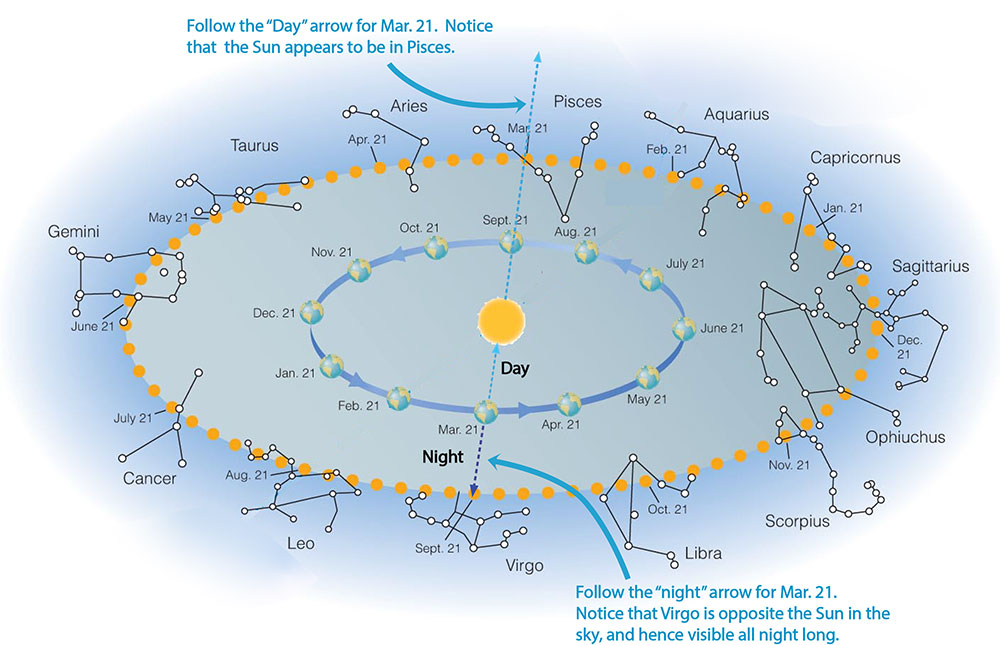So far we have explained the paths that stars on the celestial sphere appear to take through the local sky each day. But why do we see different sets of stars — that is, different constellations — at different times of year? The answer is that the night sky changes because of Earth’s orbit around the Sun, and as you’ll see, this also explains the path called the ecliptic on the celestial sphere.
Remember that the celestial sphere is an illusion created by our lack of depth perception in space. In reality, Earth orbits the Sun as shown in Figure 2.16, while the stars that dot the celestial sphere are all much farther away (and themselves located at different distances from Earth). However, because we can’t tell just by looking that the stars are so far away, Figure 2.16 imagines them located just beyond Earth’s orbit of the Sun. Moreover, because Earth follows the same orbital path year after year, we always see the Sun appearing to move among the same set of constellations — called the constellations of the zodiac — from one year to the next.
Notice that, from our vantage point on Earth, we see the Sun appear to move steadily on an eastward path through the constellations of the zodiac. Remember that this path is called the ecliptic, and this is why the ecliptic is marked on the celestial sphere (as we first saw in Figure 2.6).
To see how Earth’s orbit leads us to see different constellations at different times of year, follow along as you look at Figure 2.16:
- As you look at Earth’s orbit around the Sun, find the position labeled March 21, which represents where Earth is located each year on that date.
- Notice that if you draw a line from that position through the Sun, the Sun appears to be on the celestial sphere at the location of the yellow dot in the constellation Pisces on that date. This means that we won’t be able to see Pisces at night on March 21, because it will be in the daytime sky along with the Sun.
- But if we look in the opposite direction, following the “night” arrow, we’ll see the constellation Virgo at the point on the celestial sphere that is exactly opposite the Sun. This means we’ll see Virgo rising at sunset, reaching the meridian at midnight, and setting at sunrise.
- If you pick any other date, you’ll find the Sun in a different location along the ecliptic, and therefore will see different constellations in your night sky.

Activity
Tonight’s Sky
What is today’s date? Use Figure 2.16 to find the name of the zodiac constellation in which the Sun currently appears. What constellation of the zodiac will be on your meridian at midnight tonight? Name at least four other zodiac constellations that will be visible in your sky at midnight.
Teacher Notes: For this activity, we’ve focused on midnight because it is the easiest to read from Figure 2.16. At midnight, you’ll certainly be able to see the two zodiac constellations on either side of the one that is directly opposite the Sun. If you want to figure out what you’ll see at other times, remember that at any given moment you can see half the celestial sphere, which means roughly half of the zodiac. The caveat is that the fact that ecliptic is tilted to the celestial equator means that you rarely see exactly half of it in your sky, with the amount visible at any given moment depending on your latitude and the date and time.
Connections—Mathematics
Why are there 360° in a Circle
The choice of 360° for a full circle goes back to cultures of the ancient Middle East. No one knows for sure why they chose 360 rather than some other number to mark a full circle, but it seems very likely that one reason was the fact that the Sun takes a year to move around the full circle of the ecliptic, and 360 days is a fairly close approximation to a year. Indeed, some ancient calendars used a year with 360 days, in part because the Moon’s cycle of phases is very close to 30 days (see Section 2.3), so it seemed mathematically natural to have a year consist of 12 months of 30 days each. Ancient mathematicians also noticed other special properties of the number 360 — for example, it has 24 divisors, including every number from 1 to 10 except 7 — which may have added to a sense that 360 was an “important” number and therefore a good choice for the number of degrees in a circle.